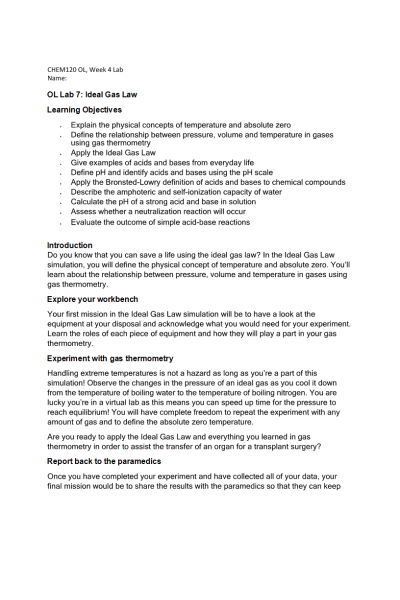CHEM 120 Week 4 Virtual Lab; Part I, Part II, Part III
-
$25.00
| Institution | Chamberlain |
| Contributor | Karin Austin |
Document Preview
OL Lab 7: Ideal Gas Law Learning Objectives
- Explain the physical concepts of temperature and absolute zero
- Define the relationship between pressure, volume and temperature in gases using gas thermometry
- Apply the Ideal Gas Law
- Give examples of acids and bases from everyday life
- Define pH and identify acids and bases using the pH scale
- Apply the Bronsted-Lowry definition of acids and bases to chemical compounds
- Describe the amphoteric and self-ionization capacity of water
- Calculate the pH of a strong acid and base in solution
- Assess whether a neutralization reaction will occur
- Evaluate the outcome of simple acid-base reactions
Introduction
Do you know that you can save a life using the ideal gas law? In the Ideal Gas Law simulation, you will define the physical concept of temperature and absolute zero. You’ll learn about the relationship between pressure, volume and temperature in gases using gas thermometry.
Explore your workbench
Your first mission in the Ideal Gas Law simulation will be to have a look at the equipment at your disposal and acknowledge what you would need for your experiment. Learn the roles of each piece of equipment and how they will play a part in your gas thermometry.
Experiment with gas thermometry
Handling extreme temperatures is not a hazard as long as you’re a part of this simulation! Observe the changes in the pressure of an ideal gas as you cool it down from the temperature of boiling water to the temperature of boiling nitrogen. You are lucky you’re in a virtual lab as this means you can speed up time for the pressure to reach equilibrium! You will have complete freedom to repeat the experiment with any amount of gas and to define the absolute zero temperature.
Are you ready to apply the Ideal Gas Law and everything you learned in gas thermometry in order to assist the transfer of an organ for a transplant surgery?
Report back to the paramedics
Once you have completed your experiment and have collected all of your data, your final mission would be to share the results with the paramedics so that they can keep
the organ safe and sound in the correct pressure and temperature conditions to make it all the way to the hospital.
Acidic life
How do acidic or alkaline foods affect the pH of our blood, and what does this even mean? Together with your lab assistant, Marie, you will explore different concepts of acids and bases, and investigate how alkaline foods can also contain acids. You will measure the pH of solutions, and dive into these to experience what happens at the molecular level.
Salty mixtures
In order to determine what reactions occur when you mix acids and bases of different strengths, you will have the freedom to mix these solutions and interpret the resulting salt products. And don’t worry if you make mistakes – in this virtual lab, you can just reset and start over! On-the- go quizzes will make sure you are up to speed, and you can always dive into the theory pages for more in-depth explanations.
Corrosive everyday chemicals
Acids and bases can be corrosive and very dangerous to handle. But they also play a fundamental role in all living things, in nature, and in the chemical industry.
Will you be able to measure the acidity of various substances around you?
Part 1: Complete Labster lab: Ideal Gas Law: Apply to Save a Life
- Purpose: Describe in complete sentences and in your own words, the purpose of this experiment.
This lab's goal is to ensure that we understand how temperature and molecular concentration might impact many scenarios, whether they occur in a clinical environment, a lab, or even in everyday life. We also learned about the Ideal Gas Law and how to use it correctly……….. Continue
| Instituition / Term | |
| Term | Summer |
| Institution | Chamberlain |
| Contributor | Karin Austin |





-80x80.JPG)



-80x80.JPG)





























































